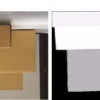Free Online Productivity Tools
i2Speak
i2Symbol
i2OCR
iTex2Img
iWeb2Print
iWeb2Shot
i2Type
iPdf2Split
iPdf2Merge
i2Bopomofo
i2Arabic
i2Style
i2Image
i2PDF
iLatex2Rtf
Sci2ools
126
Voted
ICCV
2005
IEEE
2005
IEEE
Discontinuity Preserving Stereo with Small Baseline Multi-Flash Illumination
Currently, sharp discontinuities in depth and partial occlusions in multiview imaging systems pose serious challenges for many dense correspondence algorithms. However, it is important for 3D reconstruction methods to preserve depth edges as they correspond to important shape features like silhouettes which are critical for understanding the structure of a scene. In this paper we show how active illumination algorithms can produce a rich set of feature maps that are useful in dense 3D reconstruction. We start by showing a method to compute a qualitative depth map from a single camera, which encodes object relative distances and can be used as a prior for stereo. In a multiview setup, we show that along with depth edges, binocular half-occluded pixels can also be explicitly and reliably labeled. To demonstrate the usefulness of these feature maps, we show how they can be used in two different algorithms for dense stereo correspondence. Our experimental results show that our enhanced st...
Computer Vision | Dense 3D Reconstruction | Dense Correspondence Algorithms | Dense Stereo Correspondence | Depth Edges | Enhanced Stereo Algorithms | ICCV 2005 |
| Added | 15 Oct 2009 |
| Updated | 30 Oct 2009 |
| Type | Conference |
| Year | 2005 |
| Where | ICCV |
| Authors | Rogerio Feris, Ramesh Raskar, Longbin Chen, Kar-Han Tan, Matthew Turk |
Comments (0)

